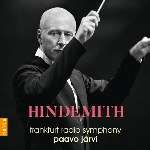|
Back
04/05/2018
Paul Hindemith: Symphony “Mathis der Maler” – Symphonic Metamorphoses on Themes of Carl Maria von Weber – Five Pieces for String Orchestra, Op. 44/4 – Ragtime (Well-Tempered)
Frankfurt Radio Symphony, Paavo Järvi (conductor)
Recording: Alte Oper, Frankfurt (October 2010, June & July 2011, January & February 2013) – 66’
Naïve V 5434 – Booklet in English, German, French

   
This is a bizarre, frustrating, and utterly disappointing recording. On paper, it should be excellent. The Frankfurt Radio Symphony is a fantastic orchestra, and Paavo Järvi has often offered intriguing interpretive stances that still respect composers’ wishes. Having two mainstays of Hindemith’s orchestral output mingling with two lesser-known and -performed works is also a bonus. Unfortunately, Järvi’s mannerisms are compounded by noticeably artificial manipulations in the recording studios, making the recording a non-starter. Many questions abound.
Why are the pieces in the order they are? Surely the witty, short, and exciting Ragtime should open the program and the most substantial work, Mathis der Maler close it. Instead, the order is reversed. Why aren’t the Five Pieces for Orchestra individually tracked? The first is three minutes long—surely enough for its own track, and the final piece (“Lebhaft”) is particularly attractive and something that I would include on a Hindemith playlist. Why are there no program notes aside from a brief blurb from Järvi?
Most egregious might be the track listing, which indicates that Ragtime is the fifth part of Hindemith’s Op. 26, the piano suite entitled 1922, which does include a movement titled “Ragtime” as its finale. However, that isn’t the piece on which this orchestral work is based. Instead, it’s a 1921 work without opus number which exists in two versions: piano four-hands, and orchestra. This is just sloppy production, through and through.
The annoying elements ooze from there into the performances. In Mathis der Maler and Symphonic Metamorphoses, Järvi oddly insists on blowing Hindemith’s tempo modifications out of proportion and making the signature martial rhythms as soggy as possible. “Ruhig” in the first movement of Mathis der Maler is interpreted as slowing to a snails pace—does “quiet” even mean slower? Likewise, in the finale of the same piece, the first climax, marked “Ein wenig breiter,” is the slowest and least exciting I’ve ever heard this passage sound. Compared to the vigor and intensity maintained at this moment by the likes of Steinberg and Blomstedt (who still respect the “a little broader” indication), Järvi slams on the breaks, making the passage sound like an accident.
Dotted rhythms throughout Metamorphoses are sometimes snappy, sometimes soggy, and never consistently in line with Hindemith’s indications. The composer does mark things differently—sometimes a staccato marking is over the dotted eighth, sometimes not—but Järvi seems to be trying to make this an academic exercise instead of using musical intuition. An example would be when the trio’s horn melody is repeated the first time, answered by the dotted rhythm in the trumpets. In the score, neither is marked staccato here, but the horns are playing a soggy version of the rhythm, the trumpets a snappy version. When the tune returns at the climax, the rhythm is so soggy that it sounds like a straight quarter note.
Is this nitpicking? Perhaps, but it is moments like these that stand out as odd and prompt questions. When research uncovers inconsistency in interpretation, it becomes difficult to take the recording seriously. These are but two examples of many through the two repertoire staples. The two lesser-known works fare better, perhaps because there is not as much precedent with which to compare them. The more one listens to and looks at this product, the more petulant and sloppy it becomes.
Simply put, skip this for the two big works and stick with the tried and true. Nothing that Järvi offers here amounts to more than mere idiosyncrasy without justification. For the Five Pieces, the Academy of St. Martin-in-the-Fields with Neville Marriner offer an excellent reading on Decca, each movement independently tracked. Likewise, this Hindemith Ragtime (again, without relationship to composer’s Op. 26) is handsomely served by the BBC Philharmonic and Yan Pascal Tortelier on Chandos.
Marcus Karl Maroney
|